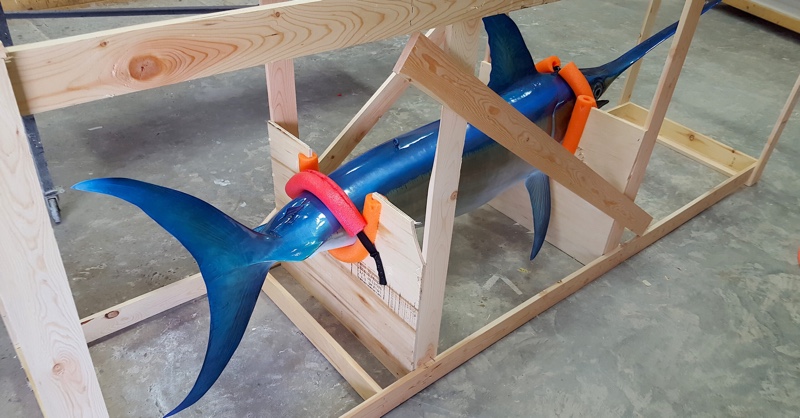Taxidermy Process
Since 1964
Taxidermy with Integrity

Molding Process
To make the perfect mount, it all starts with the perfect mold. This requires an acute, attention to detail and begins with a real fish that is fresh, or freshly frozen and in excellent condition.Our skilled artists begin by positioning the real fish in a sandbox, naturally posed. The sand supports the fish on one side while the exposed side is prepared. The month, gills and fins are cleaned, and the slime coat is removed. The skin’s texture is recreated by applying a layer of gel coat and fiberglass to obtain the contours of each scale on the exposed side of the fish. Every specific detail is captured. The fiberglass is left to dry and then the fish is flipped over, and the process is repeated. Once the fiberglass has dried on each side, the cast is opened, and the real fish is then removed. The mold is then cleaned, and our artists will correct any imperfections.
At Rinehart Taxidermy, our international collection of molded fish includes both fresh and saltwater. No matter the location or species, the molding process is the same. Each new mold is added to our inventory and used to recreate life-like trophy mounts. With thousands and thousands of molds, we are confident that we are able to recreate your catch!
Fiberglassing Your Fish – The Reproduction Process
With photos or measurements of your fish, we are able to find your perfect match in our inventory. The chosen mold is opened, and a releasing agent is brushed all over the inside surface. Then, a small amount of gel coat is brushed throughout the interior of the mold. This is followed by multiple layers of fiberglass. On large fish, we add extra fiberglass to reinforce the structural integrity. A small piece of wood is then inserted with fiberglass where the hanger will later be installed and allow you to safely display your fish.
Once both sides of the mold have been laid with gel coat and fiberglass, they are sandwiched together using a fiberglass adhesive along the edges. It is clamped together and left to harden and dry. The clamps are then removed, the mold is opened, and presto! Out comes your fiberglass fish!


Customizing & Finishing Process
During the finishing process, our artists will grind and smooth down any rough edges and clean the body of any remaining releasing agent and fiberglass residual. Bondo is used to smooth out and fill the seams. The remaining body parts are now attached including but not limited to the eyes, fins, and teeth. The bill and gills are also added when appropriate. Rinehart Taxidermy’s Aqua Eyes are used giving your fish’s eyes distinctive colors, lifelike sclera and iris bands, and realistic contours.
A hanger is attached to the back of your fish and then it is painted with a coat of primer. The primer is determined by the species of fish you caught. Most fish receive a metallic primer to enhance the sheen of the fish’s scales. However, some species are painted with a matted finish such as most sharks. The fish is then inspected to make sure no imperfections have been overlooked. Once approved, the fish is sent to the Paint Department.
Painting Process
The painting process is a crucial point in the creation of any trophy fish and must be done with great care and precision. Our highly skilled artists have years of experience and knowledge and take great pride in their work.
Once the fish has been primed, this is when the fish truly comes to life! Each fish requires a series of blended colors added one layer at a time. The lacquer paints have a transparent nature revealing the layered colors underneath. Rinehart Taxidermy takes special care to paint each fish based on species and from where the fish was caught. The result is a fish looking as alive as it was when it was still in the water.
A final clear coat is added to the fish to protect the paint as well as give it that wet look. After the fish has been inspected, it is ready to be crated.


Crating & Shipping – Getting Your Trophy Fish Home Safely
Crating a trophy mount is an art in itself. Taking into consideration the size of the fish and its destination, each crate is individually built around your trophy mount. After one last, final inspection, the fish is suspended inside the crate with only the back side of the mount touching the inside of the crate.
A reliable shipping company will be chosen to transport your fish to its final destination.

